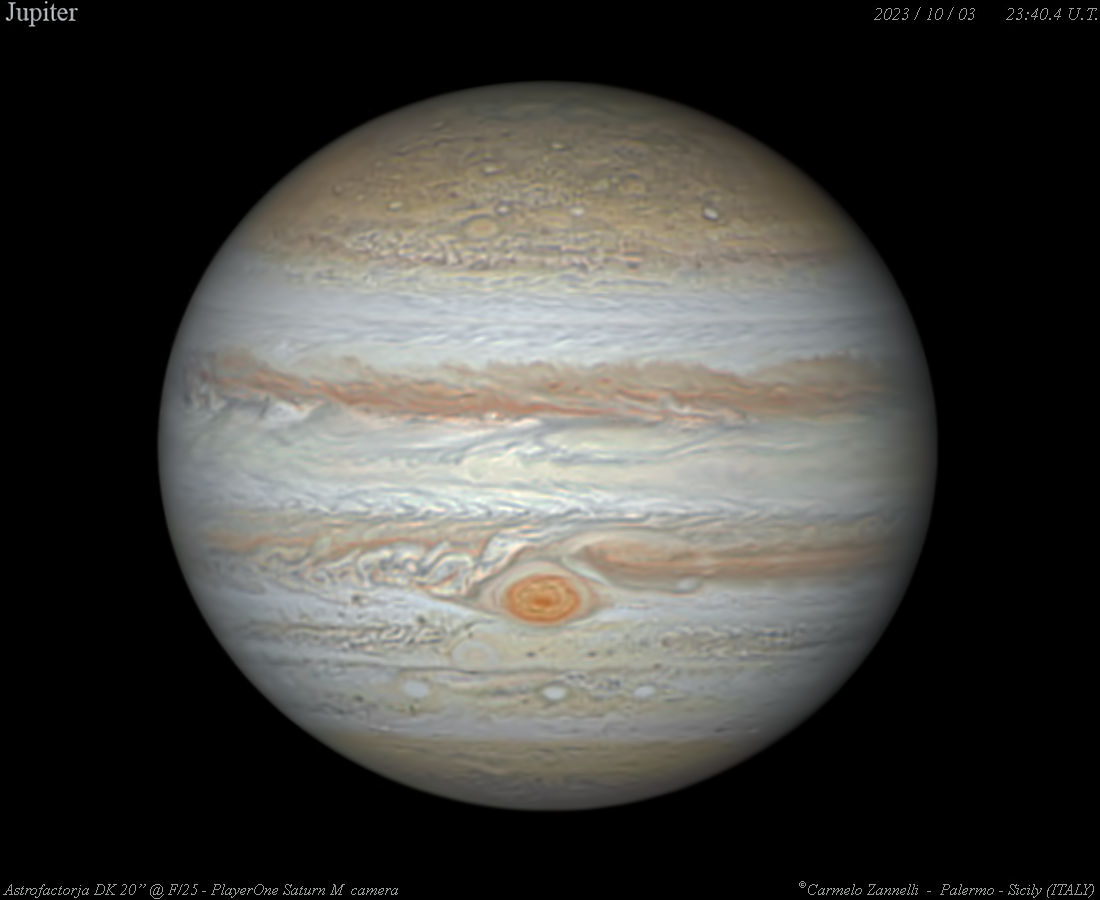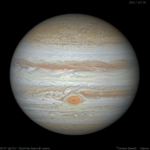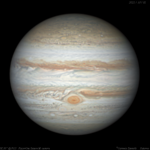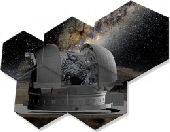*
Italiano (for English, please read below):
In queste notti autunnali, con temperature ancora miti anche di notte almeno qui in Sicilia, è molto facile imbattersi in una “stella” molto luminosa, in direzione Est, che sorge intorno alle 20:30 della nostra ora legale: è il pianeta Giove, il più grande del nostro sistema solare.
Il pianeta Giove è un soggetto molto idoneo ad essere osservato anche con un semplice binocolo che ci permetterà già di individuare le sue quattro lune principali (Io, Europa, Ganimede e Callisto), mentre con un piccolo telescopio che fornisce almeno una cinquantina di ingrandimenti, si potranno osservare le sue nuvole di gas principali suddivise in Bande (quelle arancioni e a strisce parallele) e Zone (quelle più chiare). Nelle bande le temperature sono più elevate e i gas hanno un moto discendente verso gli strati bassi dell’atmosfera, mentre le zone presentano temperature più basse con un moto ascensionale dei fluidi.
Gli astronomi ritengono che il colore più chiaro delle Zone derivi dalla presenza di ghiaccio di ammoniaca, mentre non è ancora chiaro cosa renda le bande più scure, con quel tipico color mattone. Ancora oggi, sebbene siano stati sviluppati dei diversi modelli per la struttura delle bande e delle correnti a getto, la loro origine ancora non è compresa.
Eccovi, quindi, un’immagine di Giove ripreso dal mio osservatorio nella notte tra il 03 ed il 04 Ottobre 2023, in buone condizioni di seeing (stabilità atmosferica) dove si possono vedere tutte le sue Bande e Zone ed innumerevoli dettagli e dove i vortici più o meno grandi, di forma solitamente ovale, sono visibili a tutte le latitudini e fino alle zone polari.
In primo piano, ed in passaggio al “Meridiano Centrale” di Giove, spicca la Grande Macchia Rossa, un enorme vortice anticiclonico persistente sul bordo meridionale della Banda equatoriale meridionale, le cui dimensioni variano nel corso degli anni e che per grandezza potrebbe attualmente contenere, per circa due volte, il nostro pianeta Terra. Sui bordi della Macchia Rossa, i venti soffiano a velocità impressionanti fino a circa 430 Km/h e la sua temperatura è più fredda (e quindi, raggiunge altitudini maggiori) della maggior parte delle altre nubi sul pianeta.
Grazie per al Vs. cortese attenzione e… ad maiora semper!
Dettagli Tecnici:
Telescopio Astrofaktorja DK20″ @ ~ F/25 – Televue 2″ PowerMate Barlow 2x – Baader RGB filters – Player One Saturn M camera – Seeing 7,5/10 in R band – sito: Palermo @ my personal Observatory
**************************************************************************************************************************************************************************
English:
In these autumn nights, with temperatures still mild even at night at least here in Sicily, it is very easy to come across a very bright “star”, heading towards the East, which rises around 8.30pm our summer time: it is the planet Jupiter, the largest in our solar system.
The planet Jupiter is a very suitable subject to be observed even with simple binoculars which will already allow us to identify its 4 main moons (Io, Europa, Ganymede and Callisto), while with a small telescope which provides at least fifthy enlargements, you will be able to observe its main gas clouds divided into Belts (the orange ones and with parallel stripes) and Zones (the lighter ones).
In Jupiter belts, the temperatures are higher and the gases have a descending motion towards the lower layers of the atmosphere, while the zones have lower temperatures with an ascending motion of the fluids. Astronomers believe that the lighter color of the Zones derives from the presence of ammonia ice, while it is not yet clear what makes the bands darker, with that typical brick color. Even today, although different models for the structure of bands and jet streams have been developed, their origin is still not understood.
Here, therefore, is this image of Jupiter taken from my observatory on the night between 03 and 04 October 2023 in good seeing conditions (about 7,5/10 in Red channel @ 580nm.) where you can see all its Belts and Zones and countless several details and where the vortices more or less large are visibles, usually oval in shape, at all latitudes and up to the polar areas.
In the foreground, and in transit to the “Central Meridian” of Jupiter, the Great Red Spot stands out, an enormous anticyclonic vortex persistent on the southern edge of the southern equatorial band, whose dimensions vary over the years and which in terms of size could currently contain, approximately twice, our planet Earth. At the edges of the Red Spot, winds blow at impressive speeds of up to around 430 km/h and its temperature is colder (and therefore, reaches higher altitudes) than most other clouds on the planet.
Thank you for your kind attention and… ad maiora semper!
Technical Details:
Astrofaktorja DK20″ telescope @ ~ F/25 – Televue 2″ PowerMate Barlow 2x – Baader RGB filters – Player One Saturn M camera – Seeing 7.5/10 in R band – site: Palermo @ my personal Observatory.



